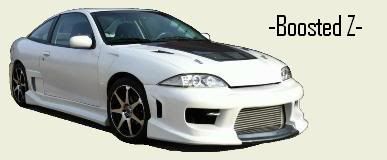Whats the best route for the crank case vent...
1) case vent ----> catch can ----> breather filter
2) case vent ----> catch can ----> intake of turbo

12.6 @ 114.6 MPH
Intake of turbo or to the intake manifold with a check valve in it.
Case vent - catch can - check valve - turbo intake
Wagonwes wrote:Intake of turbo or to the intake manifold with a check valve in it.
Don't use the intake manifold if you are boosted. You're going to need constant vacuum to keep pulling from the crank case vent to the catch can, and the intake mani will obviously have positive pressure under boost.
I'd also recommend using a baffled catch can. The cheaper hollow shell versions don't really catch anything (this would be similar to cutting out the baffling from inside the valve cover).

There are quite a few boosted cars from the factory that have the PCV going to the intake manifold with a check valve. Of course the intake of the turbo is a better spot, but sometimes due to packaging it can be inconvenient or not possible.
Yeah, go to pre-turbo. And Put baffles in the catch can. Unless you feel like paying over 200 bucks for a catch can you wont get one with baffles.
1994 Saturn SL2 Home Coming Edition: backup car
2002 Chevy Cavalier LS Sport Coupe: In a Junk Yard
1995 Mazda Miata R-package Class=STR
Sponsored by:
Kronos Performance
WPI Class of '12 Mechanical Engineering
WPI SAE Risk and Sustainability Management Officer
Routing it to the turbo inlet is no issue. Why not just use a breater filter after the can? Why would vac on the vent be benificial over just simply venting it through a breather filter?

12.6 @ 114.6 MPH
but then those fumes get reintroduced in the combustion chamber. Why is that better than just venting them..

12.6 @ 114.6 MPH
Because a baffled catch can makes all the oil and crap drop out of the fumes and just mostly air goes back into the intake.
1994 Saturn SL2 Home Coming Edition: backup car
2002 Chevy Cavalier LS Sport Coupe: In a Junk Yard
1995 Mazda Miata R-package Class=STR
Sponsored by:
Kronos Performance
WPI Class of '12 Mechanical Engineering
WPI SAE Risk and Sustainability Management Officer
right by why is that spent air good to get sucked back in again rather than just being vented to the atmosphere... Why reuse that air or exhaust fumes at all.

12.6 @ 114.6 MPH
Because, you need vacuum to properly vent the crank case. I guess you could run an electric vac pump, but those are expensive and heavy.
1994 Saturn SL2 Home Coming Edition: backup car
2002 Chevy Cavalier LS Sport Coupe: In a Junk Yard
1995 Mazda Miata R-package Class=STR
Sponsored by:
Kronos Performance
WPI Class of '12 Mechanical Engineering
WPI SAE Risk and Sustainability Management Officer
Like said, you need vac to pull the fumes. If you just run a breather to atmosphere, there's nothing to pull the fumes. Your PCV is designed to be vacuum controlled, if you're are just running to a breather you're only dumping the little amount of fumes that get pushed out on their own, and meanwhile crankcase pressure will build.
Run a baffled catch can and check valve and you won't need to worry about anything harmful recirculating.

--Glowin Cavy-- wrote:right by why is that spent air good to get sucked back in again rather than just being vented to the atmosphere... Why reuse that air or exhaust fumes at all.
because its an emissions devise. venting to the atmosphere is illegal.
the crankcase venting system is useless unless vacuum is applied all the time. if you route the line to the intake then you are defeating the purpose of it. you want to have vacuum at the crankcase at all times. if you just vent the crankcase to atmosphere your allowing the crankcase to pressurize. a pressurized crankcase will cause engine seals to blow and will decrease engine power.
if you route the crankcase vent to the turbo inlet then the pcv system will always have a vacuum applied.
I'll go ahead and route it to the turbo inlet, but I'm still a little unclear on things...
So the point of reusing the fumes/air/gasses is an emissions thing... I got that.
What I still don't really understand is how pressure would build it its vented to the atmosphere? If its vented, its vented meaning there's a vent... for the pressure to escape from.
I'm also unclear on how it would "cause engine seals to blow"... It there was pressure, yes I get how that could mess up seals, however with a vent there shouldn't be pressure. I've used only a breather on a few other boosted cars with no ill effects. I asked about it in the post just in case it was truly better to have a little suction on the vent. Another thing I'm wondering... is there really actually any suction on the crank vent when its routed to the intake? I don't think there would be unless you have a clogged filter... seems to me this is purely an emissions thing as far as reusing the gasses rather than a suction actually being needed...

12.6 @ 114.6 MPH
--Glowin Cavy-- wrote:I'll go ahead and route it to the turbo inlet, but I'm still a little unclear on things...
So the point of reusing the fumes/air/gasses is an emissions thing... I got that.
What I still don't really understand is how pressure would build it its vented to the atmosphere? If its vented, its vented meaning there's a vent... for the pressure to escape from.
I'm also unclear on how it would "cause engine seals to blow"... It there was pressure, yes I get how that could mess up seals, however with a vent there shouldn't be pressure. I've used only a breather on a few other boosted cars with no ill effects. I asked about it in the post just in case it was truly better to have a little suction on the vent. Another thing I'm wondering... is there really actually any suction on the crank vent when its routed to the intake? I don't think there would be unless you have a clogged filter... seems to me this is purely an emissions thing as far as reusing the gasses rather than a suction actually being needed...
The reason why you want a vacuum at all times is more of a performance thing. Adding vacuum underneath the piston and pulling it down is essentially the same as adding pressure on top (turbo or supercharger) from the top and pushing it down. This is why some drag cars have belt driven vacuum pumps or electric ones like Leafy mentioned (this also helps maintain a stronger ring seal). You won't blow any seals out unless you actually PRESSURIZE the crankcase. As in hook a line directly from your intake manifold to the crankcase with no check valve.
Even if you use a vented catch can, as in not to the inlet of the turbo or intake manifold with a check valve, the pressure in the crankcase is always higher than atmospheric pressure. Granted the pressure would be higher than if you had vacuum pulling against it, but it still technically a vacuum since it is lower than atmospheric. They actually use to vent directly to the atmosphere in the 50s and earlier (if I remember correctly), supposedly you could see where all the oil in the center of the road was because the vent tubes went under the firewall in the middle of the car. Nowadays the only real reason they don't do that is for emissions reasons.
Just realized that last part was worded strangely, and a bit incorrectly. There is a slight pressure in the crankcase at all times, if you vent to atmosphere the atmospheric pressure is lower, so it will flow from the crankcase to the atmosphere - as in the case of a vented catch can. If you have a vacuum at all times, I.E. turbo inlet, you will still have higher pressure in the crankcase than the turbo inlet, but the pressure difference will be higher giving you a slight advantage over venting directly to atmosphere. If you go to the intake manifold with a check valve, you will spend almost all your time in vacuum, so the pressure will flow from the crankcase to the manifold just like it would if you went to the inlet of the turbo. Now when you get into boost the check valve will keep the crankcase from being pressurized to whatever pressure your turbo or supercharger is at, which would cause problems, to say the least. The thing is, the pressure in the crankcase when the check valve is forced shut is still fairly low - and since you spend almost all of your time out of boost - is almost negligible.
Valve cover > turbo. Done.
emissions is not concerned in a class 8 turbocharged diesel semi truck.you're talking 15-16 litre motors.they vent into atmosphere on everyone of those engines.i say from can down to tube with angle cut facing rear [bernoulli effect] this creates a small vacuum.go look at a big truck engine you'll see.the vent comes directly from valve cover.good luck.







